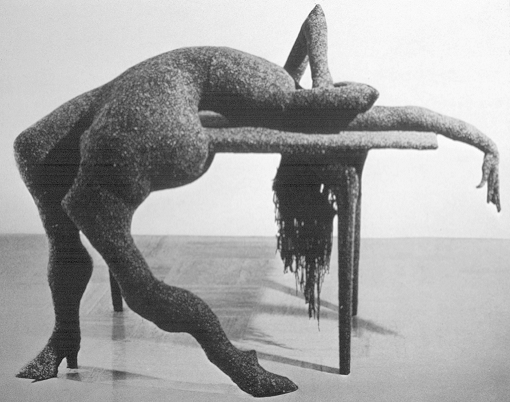The Surrealist movement was founded in Paris 1924 by a small group of writers and artists who sought to channel the unconscious as a means to unlock the power of the imagination.
Disdaining rationalism and literary realism, and powerfully influenced by Sigmund Freud, the Surrealists believed the conscious mind repressed the power of the imagination, weighting it down with taboos.
>>> david-lynchs-surrealism
>>> joseph-beuys
>>> david-lynchs-art-crazy-clown-time
>>> Allan McCollum the Americ...
>>> joseph-beuys
>>> david-lynchs-art-crazy-clown-time
>>> Allan McCollum the Americ...
>>> joseph-beuys-art
Influenced also by Karl Marx, they hoped that the psyche had the power to reveal the contradictions in the everyday world and spur on revolution. Their emphasis on the power of the imagination puts them in the tradition of Romanticism, but unlike their forbears, they believed that revelations could be found on the street and in everyday life. The Surrealist impulse to tap the subconscious mind, and their interests in myth and primitivism, went on to shape the Abstract Expressionists, and they remain influential today.
Artists:

André Breton

Max Ernst

Salvador Dalí

Pablo Picasso

Alberto Giacometti

Joan Miró

Louise Bourgeois

Rene Magritte

Man Ray

Yves Tanguy

Dorothea Tanning
by artstory
Feminism and Women Surrealists
The Surrealists have often been depicted as a tightly knit group of men, and their art often envisioned women as wild 'others' to the cultured, rational world. Work by feminist arthistorians has since corrected this impression, not only highlighting the number of women Surrealists who were active in the group, particularly in the 1930s, but also analyzing the gender stereotypes at work in much Surrealist art. Feminist art critics, such as Dawn Ades, Mary Ann Caws, and Whitney Chadwick, have devoted several books and exhibitions to this subject.
While most of the male Surrealists, especially Hans Bellmer, Man Ray, and Salvador Dalí, repeatedly distorted the female form, and depicted women as muses, much in the way that male artists had for centuries, female Surrealists such as Claude Cahun, Unica Zurn, Lee Miller, Leonora Carrington, and Dorothea Tanning, sought to address the problematic adoption of psychoanalysis that often cast women as somehow monstrous. Thus, many female Surrealists experimented with cross-dressing and depicted themselves as animals or mythic creatures.
Though the Surrealist movement was officially founded in 1924, the term was first coined in 1917, when Guillaume Apollinaire used it in program notes for the ballet Parade, written byPablo Picasso, Leonide Massine, Jean Cocteau, and Erik Satie. It began as a literary group strongly allied to the Dada movement, and emerged in the wake of the collapse of the group in Paris, when André Breton's eagerness to bring purpose to the group clashed with Tristan Tzara's anti-authoritarianism. Breton - who is occasionally described as the 'Pope' of Surrealism - would go on to be the most important figure in the movement, the impresario whose strong leadership gave it cohesion through its many reincarnations until his death in 1966.
Feminism and Women Surrealists
The Surrealists have often been depicted as a tightly knit group of men, and their art often envisioned women as wild 'others' to the cultured, rational world. Work by feminist arthistorians has since corrected this impression, not only highlighting the number of women Surrealists who were active in the group, particularly in the 1930s, but also analyzing the gender stereotypes at work in much Surrealist art. Feminist art critics, such as Dawn Ades, Mary Ann Caws, and Whitney Chadwick, have devoted several books and exhibitions to this subject.
While most of the male Surrealists, especially Hans Bellmer, Man Ray, and Salvador Dalí, repeatedly distorted the female form, and depicted women as muses, much in the way that male artists had for centuries, female Surrealists such as Claude Cahun, Unica Zurn, Lee Miller, Leonora Carrington, and Dorothea Tanning, sought to address the problematic adoption of psychoanalysis that often cast women as somehow monstrous. Thus, many female Surrealists experimented with cross-dressing and depicted themselves as animals or mythic creatures.
Artists:

André Breton

Max Ernst

Salvador Dalí

Pablo Picasso

Alberto Giacometti

Joan Miró

Louise Bourgeois

Rene Magritte

Man Ray

Yves Tanguy

Dorothea Tanning

Custom Search




.jpg)























Dan Zukovic's "DARK ARC", a surreal modern noir dark comedy called "Absolutely brilliant...truly and completely different..." in Film Threat, was recently released on DVD through Vanguard Cinema(http://www.vanguardcinema.com/darkarc/darkarc.htm), and is currently
ReplyDeletedebuting on Cable Video On Demand. The film had it's World Premiere at the Montreal Festival, and it's US Premiere at the Cinequest Film Festival. Featuring Sarah Strange ("White Noise"), Kurt Max Runte ("X-Men", "Battlestar Gallactica",) and Dan Zukovic (director and star of the cult comedy "The Last Big Thing"). Featuring the glam/punk tunes "Dark Fruition", "Ire and Angst" and "F.ByronFitzBaudelaire", and a dark orchestral score by Neil Burnett.
TRAILER : http://www.youtube.com/watch?v=mPeG4EFZ4ZM
***** (Five stars) "Absolutely brilliant...truly and completely different...something you've never tasted
before..." Film Threat
"A black comedy about a very strange love triangle" Seattle Times
"Consistently stunning images...a bizarre blend of art, sex, and opium, "Dark Arc" plays like a candy-coloured
version of David Lynch. " IFC News
"Sarah Strange is as decadent as Angelina Jolie thinks she is...Don't see this movie sober!" Metroactive Movies
"Equal parts film noir intrigue, pop culture send-up, brain teaser and visual feast. " American Cinematheque
Excellent creation . So i admire .
ReplyDelete